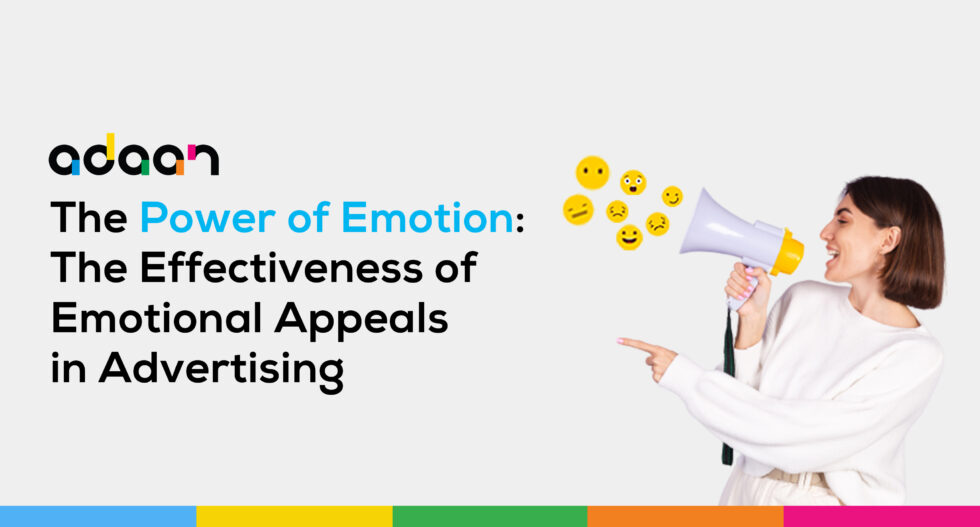What makes you reach for a certain product or service over another? Is it the practical benefits or the emotional connection it sparks within you? The answer, for many, is the latter. Emotions play a powerful role in our decision-making process, and professional advertisers have long known this.
By tapping into our feelings, ads not only capture our attention but also resonate with us on a deeper level. This is the power of emotional effectiveness in advertising, and it’s a technique that has been used to great effect throughout history.
From Coca-Cola’s “Share a Coke” campaign to Nike’s “Just Do It” slogan, emotional effectiveness in advertising has become a cornerstone of modern advertising, and for good reason. By tapping into our emotions, ads can influence our thoughts and behaviours in ways that rational arguments cannot.
Emotions can create a sense of urgency or desire for a product, and they can also help us remember a brand or product more vividly. When we feel an emotional connection to a brand, we are more likely to remain loyal to it and recommend it to others.
In this article, we will talk about the emotional effectiveness of commercial advertisements, the importance of emotions in consumer decision-making and take a closer look at the history of emotional appeals in advertising.
The Science Behind Emotional Appeals in Advertising
Emotions are powerful. They can make us feel happy, sad, angry, or excited. And when it comes to advertising effectiveness, emotions can be a driving force in consumer behaviour. That’s why companies have been using emotional appeals in their ads for years because they know it works.
Think about it – have you ever seen an ad that made you laugh, cry, or feel inspired? Chances are, that ad was using emotional appeal to target your needs and desires. Emotional appeal for advertising effectiveness aims to trigger emotions rather than rational thoughts, making it nearly twice as effective as a rational approach.
So how do companies do it? Well, they use a variety of techniques, such as personal appeal, social appeal, humour appeal, fear appeal, sexual appeal, and more depending on the product or service they are trying to sell.
For example, an ad for a luxury car might use a romantic appeal to target consumers who want to feel special and loved. Or an ad for a fitness product might use an empathy appeal to connect with consumers who struggle with their weight or self-confidence.
Let us take a look at some of the key ways in which marketers spark emotions through advertising:
1. Storytelling: People love stories, and companies use this to their advantage by telling stories in their ads. These stories often have relatable characters or situations that tug at the viewers’ heartstrings. This helps create an emotional connection with the audience.
2. Humour: Humour is a great way to create an emotional appeal in advertising effectiveness. When people laugh, they feel good, and they’re more likely to remember the ad. Humour can be used to make a brand seem approachable and friendly.
3. Music: Music can evoke strong emotions in people, and companies use this to their advantage in their ads. Whether it’s a catchy jingle or a well-known song, the right music can create a powerful emotional response.
4. Personalization: Personalization is becoming increasingly popular in advertising effectiveness. Companies use data to create personalised ads that speak directly to the viewer. When an ad feels like it was made just for them, people are more likely to engage with it emotionally.
5. Visuals: Powerful visuals can create an emotional response in viewers. Whether it’s stunning landscapes, cute animals, or heartwarming scenes, visuals can help create a connection between the viewer and the brand.
But it’s not just about targeting emotions – it’s also about creating a lasting impression. The impact of emotions on brand recall and recognition is huge. When consumers have a positive emotional experience with a brand, they are more likely to remember it and feel a connection to it.
This is why companies like Coca-Cola and Dove have been so successful with their emotional advertising effectiveness. They understand that emotions can build brand loyalty and create long-term relationships with consumers.
In order to create a successful emotional appeal ad, companies need to visualise their business mission and support their customers. They also need to combine a few emotions in one ad to make it more powerful and memorable. And let’s not forget about the importance of storytelling – a great emotional appeal and tells a story that resonates with the viewer and creates an emotional connection.
Examples of Effective Emotional Appeals in Advertising
Advertising effectiveness thrives on emotional appeals that resonate with consumers. Coca-Cola’s “Share a Coke” campaign fostered a sense of friendship by personalising bottles with popular names. Apple’s “Think Different” campaign inspired creativity and individuality. Nike’s “Just Do It” campaign motivated determination to pursue dreams.
Budweiser’s “The Buddy Cup” commercial tugged at heartstrings with its heartwarming story of a man and his loyal dog, igniting feelings of love and loyalty. These emotional appeals capture the essence of human emotions, making the ads relatable and engaging, and influencing consumers in a profound way.
Let us take a look at some of the most effective campaigns that sparked a range of emotions among the audience:
Coca-Cola’s “Share a Coke” Campaign
Coca-Cola’s “Share a Coke” campaign is a prime example of how emotional appeal can be a game-changer in advertising. The campaign, which took the world by storm, was all about personalization. Coke bottles were printed with popular names, creating a unique and special experience for consumers.
Seeing their own names or the names of loved ones on a Coke bottle triggered a flood of emotions – memories of shared moments, laughter-filled gatherings, and heartwarming experiences.
The campaign tapped into deep-seated human desires for connection and belonging. It created a sense of community, as people eagerly searched for bottles with their names or the names of their friends and family. It fostered positive emotions of friendship, joy, and togetherness, evoking warm feelings that resonated with consumers on a personal level.
The emotional bond that the “Share a Coke” campaign created translated into positive brand affinity and influence purchasing decisions. Consumers were more likely to choose Coca-Cola over other beverages because of the emotional resonance they had with the brand. It created a lasting impact, leaving an indelible mark on consumers’ hearts and minds.
Apple’s “Think Different” Campaign
The Apple “Think Different” campaign, launched in 1997, was a defining moment in the company’s marketing history. The campaign’s goal was to reposition Apple as an innovative, cutting-edge brand that valued creativity, individuality, and nonconformity.
The campaign featured a series of black-and-white print ads and TV commercials showcasing historical figures such as Albert Einstein, Martin Luther King Jr., Mahatma Gandhi, and others who had “changed the world” by thinking differently.
The “Think Different” campaign evoked a sense of nostalgia, admiration, and inspiration by featuring iconic historical figures who embody the values of creativity, innovation, and individuality. The use of a powerful soundtrack and captivating visuals reinforced the emotional resonance of the message.
The campaign also taps into consumers’ desire for personal identity and self-expression. By positioning Apple as a brand that values diversity and uniqueness, the campaign created a sense of community and belonging among consumers. This emotional connection influences consumer attitudes and behaviours, fostering brand loyalty and advocacy.
Nike’s “Just Do It” Campaign
Nike’s “Just Do It” campaign has been an emotional powerhouse in the advertising world for over three decades. It’s more than just a tagline – it’s a call to action that resonates with our inner drive to overcome challenges and reach for the stars.
Think about those moments when you’ve felt like giving up, but then you remember “Just Do It.” It’s that extra push you need to keep going, to push through the pain, and to conquer the seemingly impossible. Nike’s campaign speaks to our universal desire for achievement and success, igniting a fire within us to strive for greatness.
What makes this campaign truly impactful is its powerful storytelling. We’ve all been moved by the real-life stories of athletes who have faced adversity, yet persevered and achieved their dreams. These stories are a reminder that we are capable of greatness, regardless of our background or limitations.
In a world filled with challenges and obstacles, Nike’s “Just Do It” campaign resonates with us on an emotional level. It’s a reminder to never give up, to push beyond our limits, and to chase our dreams with unwavering determination.
Budweiser’s “The Buddy Cup” Commercial
Budweiser’s “The Buddy Cup” commercial was a heartwarming and relatable portrayal of friendship that resonated with viewers on an emotional level. The commercial depicted a group of friends gathered at a lively bar, fully immersed in the excitement of a football game. Each friend held a Buddy Cup that connected to their Facebook accounts.
As the friends clinked their cups in celebration, the cups worked their magic, notifying the users that they had become friends on social media. The commercial showcased the joy and delight that came with forming new connections and bonding over shared experiences. It captured the thrill of celebrating victories with friends and the warmth of camaraderie that came with it.
The commercial also added a touch of humour with creative cup-clinking gestures, like tapping cups with their foreheads or even noses! This added an element of fun and playfulness to the commercial, making it enjoyable and memorable for viewers.
Furthermore, the commercial presented a fresh and innovative concept with the Buddy Cup. It was a unique blend of technology and socialising, showcasing Budweiser’s commitment to creating memorable and meaningful experiences for its consumers.
The Pitfalls of Overusing Emotional Appeals in Advertising
Emotional appeals have long been a staple in advertising effectiveness, aiming to tap into people’s feelings to create a connection with a product or brand. However, overusing emotional appeals can backfire, leading to pitfalls that harm both consumers and advertisers alike.
One of the dangers of excessive emotional appeals is the manipulation of consumers’ emotions. When emotions are exploited solely for commercial gain, it can lead to feelings of deception or manipulation among consumers, eroding trust and credibility in the long run.
To avoid the pitfalls of overusing emotional appeals in advertising, it is essential for advertisers to strike a balance and be mindful of their use. Here are some pointers to consider:
1. Authenticity: Emotional appeals should be genuine and aligned with the brand’s values and identity. It is better to avoid contrived or exaggerated emotional stories that can come across as inauthentic or insincere.
2. Relevance: Emotional appeals should be relevant to the product or service being advertised. They should enhance the core message of the advertisement and not overshadow the product’s features or benefits.
3. Variety: Avoid relying solely on emotional appeals in advertising. It is suggested to use a mix of emotional, rational, and factual appeals to create a balanced and compelling message that resonates with consumers on multiple levels.
4. Moderation: Use emotional appeals judiciously and avoid overusing them. Too much emotion may lead to emotional fatigue or desensitization among consumers, diminishing the impact of emotional appeals in future advertising efforts.
5. Ethical Considerations: Advertisers should be mindful of the ethical implications of manipulating consumers’ emotions for commercial gain. Respect consumers’ emotions and avoid exploiting or manipulating them for short-term gains.
Following the above-mentioned pointers such as authenticity, relevance, variety, moderation, and ethical considerations can help advertisers avoid the pitfalls of emotional appeal in advertising. Emotional appeals should be genuine, relevant to the product or service, used judiciously in combination with other appeals, and mindful of ethical implications.
Final Words
Emotions are a powerful tool in advertising that allows brands to create relatable and engaging campaigns that connect with consumers on a personal level. Through techniques such as storytelling, humour, music, personalization, and visuals, emotional appeals go beyond rational arguments to evoke a strong emotional response from consumers. These emotional connections can result in increased attention, sales, brand loyalty, and meaningful relationships with consumers.
By harnessing the power of emotions in advertising, marketers can create impactful campaigns that leave a lasting impression and influence consumer behaviour for long-term success.
So, whether it’s a heartwarming story, a funny commercial, or a visually stunning ad, the use of emotions in advertising can captivate audiences and foster a deep connection with your brand, ultimately driving business success in today’s competitive marketing landscape.
With emotional intelligence, empathy, and a deep understanding of consumer emotions, brands can create advertising that resonates with their target audience and makes a lasting impact, leading to successful marketing campaigns that stand out in the crowded advertising space.
FAQs
1. What are emotional appeals in advertising?
Emotional appeals in advertising are strategies that evoke feelings and emotions in consumers, such as joy, fear, sadness, or nostalgia, to create a connection and influence their purchasing behaviour.
2. Why are emotions important in advertising?
Emotions are important in advertising because they create a deeper connection with consumers, increase attention, drive brand loyalty, and influence purchasing decisions on a subconscious level.
3. Can you provide some examples of effective emotional appeals in advertising?
Some of the most famous examples of a brand campaign that connected with the audience on an emotional level include:
- Coca-Cola’s “Share a Coke” campaign
- Apple’s “Think Different” campaign
- Nike’s “Just Do It” campaign
- Budweiser’s “The Buddy Cup” commercial
4. What are the potential downsides of relying too heavily on emotional appeals in advertising?
Potential downsides of relying too heavily on emotional appeals in advertising include the risk of appearing manipulative or insincere, creating short-term emotional responses without long-term brand loyalty, and neglecting the rational aspects of decision-making.
5. How can companies strike the right balance between emotional appeals and promoting their product or message?
Companies can strike the right balance between emotional appeals and promoting their product or message by understanding their target audience, aligning emotions with their brand values, using emotional appeals that are authentic and relevant, and integrating emotional appeals with rational messaging to create a holistic marketing approach.






